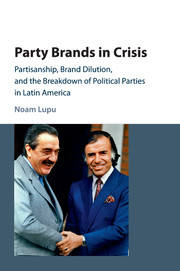 Party Brands in Crisis
Party Brands in Crisis Book contents
- Frontmatter
- Dedication
- Contents
- List of figures
- List of tables
- Acknowledgments
- 1 Why do parties break down?
- 2 Brand dilution and party breakdown
- 3 Explaining party breakdown across Latin America
- 4 Argentina: Peronism survives, Radicals collapse
- 5 Venezuela: AD and COPEI break down
- 6 Party brands and mass partisanship: experimental evidence
- 7 Party brands and mass partisanship in comparative perspective
- 8 Parties, partisanship, and democracy: conclusions
- Appendix
- Bibliography
- Index
2 - Brand dilution and party breakdown
Published online by Cambridge University Press: 18 December 2015
- Frontmatter
- Dedication
- Contents
- List of figures
- List of tables
- Acknowledgments
- 1 Why do parties break down?
- 2 Brand dilution and party breakdown
- 3 Explaining party breakdown across Latin America
- 4 Argentina: Peronism survives, Radicals collapse
- 5 Venezuela: AD and COPEI break down
- 6 Party brands and mass partisanship: experimental evidence
- 7 Party brands and mass partisanship in comparative perspective
- 8 Parties, partisanship, and democracy: conclusions
- Appendix
- Bibliography
- Index
Summary
There are periods in which the heat of partisan debate slackens and becomes almost perfunctory, and the positions of the parties become relatively indistinct on basic issues. In times such as these, even the person sensitive to a range of political philosophies may not feel this knowledge to be helpful in an evaluation of current politics.
– Campbell et al. (1960: 256)Political executives pursue substantive policy objectives when they feel secure in office, but at moments of political crisis the balance between survival and substance tips toward survival.
– Ames (1987: 187)One-quarter of the established political parties in Latin America have broken down since the mid-1990s. These were not fleeting organizations: some were more than a century old. Many had survived economic booms and busts, repressive dictators, guerrilla insurgencies, even revolutions. What brought these once powerful political organizations to their knees so quickly? Why did voters abandon the parties they had once been so attached to – parties that some had risked jail, torture, or even death to defend just a few years earlier?
Answering these questions requires knowing something about how citizens form political attitudes and make voting decisions. It also requires that we understand the incentives of party elites, and how their actions affect mass behavior. Explanations of party decline, particularly in studies of Latin America, typically focus on elite strategies and structural constraints. But party breakdown is fundamentally about the attitudes and choices of individual voters. If we want to understand why established parties break down, our macro-level explanations must start with a model of how individual citizens relate to parties.
To understand party breakdown in Latin America, we must understand how party brands influence voters' choices. When a party's brand is clear, some voters form strong attachments to it, attachments so strong that voters may ignore the party's actual performance in office. But at times, parties become indistinguishable and their brands blur. When this happens, voters detach from parties and start to look at the party's performance more seriously when making voting decisions. Parties become increasingly susceptible to voters' short-term retrospective evaluations. When established parties both dilute their brands and perform poorly in office, voters defect en masse from established parties.
Party brands are an important heuristic for voters. They may pay little attention to politics and lack the time or resources to evaluate each candidate's record or proposals in detail.
- Type
- Chapter
- Information
- Party Brands in CrisisPartisanship, Brand Dilution, and the Breakdown of Political Parties in Latin America, pp. 16 - 41Publisher: Cambridge University PressPrint publication year: 2016
- 1
- Cited by
